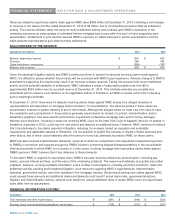GE 2014 Annual Report Download - page 165
Download and view the complete annual report
Please find page 165 of the 2014 GE annual report below. You can navigate through the pages in the report by either clicking on the pages listed below, or by using the keyword search tool below to find specific information within the annual report.
GE 2014 FORM 10-K 145
FINANCIAL STATEMENTS PRESENTATION & POLICIES
FAIR VALUE MEASUREMENTS
For financial assets and liabilities measured at fair value on a recurring basis, fair value is the price we would receive to sell an
asset or pay to transfer a liability in an orderly transaction with a market participant at the measurement date. In the absence
of active markets for the identical assets or liabilities, such measurements involve developing assumptions based on market
observable data and, in the absence of such data, internal information that is consistent with what market participants would
use in a hypothetical transaction that occurs at the measurement date.
Observable inputs reflect market data obtained from independent sources, while unobservable inputs reflect our market
assumptions. Preference is given to observable inputs. These two types of inputs create the following fair value hierarchy:
Level 1 – Quoted prices for identical instruments in active markets.
Level 2 – Quoted prices for similar instruments in active markets; quoted prices for identical or similar instruments in markets
that are not active; and model-derived valuations whose inputs are observable or whose significant value drivers are
observable.
Level 3 – Significant inputs to the valuation model are unobservable.
We maintain policies and procedures to value instruments using the best and most relevant data available. In addition, we
have risk management teams that review valuation, including independent price validation for certain instruments. With regard
to Level 3 valuations (including instruments valued by third parties), we perform a variety of procedures to assess the
reasonableness of the valuations. Such reviews, which may be performed quarterly, monthly or weekly, include an evaluation
of instruments whose fair value change exceeds predefined thresholds (and/or does not change) and consider the current
interest rate, currency and credit environment, as well as other published data, such as rating agency market reports and
current appraisals. These reviews are performed within each business by the asset and risk managers, pricing committees
and valuation committees. A detailed review of methodologies and assumptions is performed by individuals independent of the
business for individual measurements with a fair value exceeding predefined thresholds. This detailed review may include the
use of a third-party valuation firm.
RECURRING FAIR VALUE MEASUREMENTS
The following sections describe the valuation methodologies we use to measure different financial instruments at fair value on
a recurring basis.
Investments in Debt and Equity Securities. When available, we use quoted market prices to determine the fair value of
investment securities, and they are included in Level 1. Level 1 securities primarily include publicly traded equity securities.
For large numbers of investment securities for which market prices are observable for identical or similar investment securities
but not readily accessible for each of those investments individually (that is, it is difficult to obtain pricing information for each
individual investment security at the measurement date), we obtain pricing information from an independent pricing vendor.
The pricing vendor uses various pricing models for each asset class that are consistent with what other market participants
would use. The inputs and assumptions to the model of the pricing vendor are derived from market observable sources
including: benchmark yields, reported trades, broker/dealer quotes, issuer spreads, benchmark securities, bids, offers, and
other market-related data. Since many fixed income securities do not trade on a daily basis, the methodology of the pricing
vendor uses available information as applicable such as benchmark curves, benchmarking of like securities, sector groupings,
and matrix pricing. The pricing vendor considers available market observable inputs in determining the evaluation for a
security. Thus, certain securities may not be priced using quoted prices, but rather determined from market observable
information. These investments are included in Level 2 and primarily comprise our portfolio of corporate fixed income, and
government, mortgage and asset-backed securities. In infrequent circumstances, our pricing vendors may provide us with
valuations that are based on significant unobservable inputs, and in those circumstances we classify the investment securities
in Level 3.
























